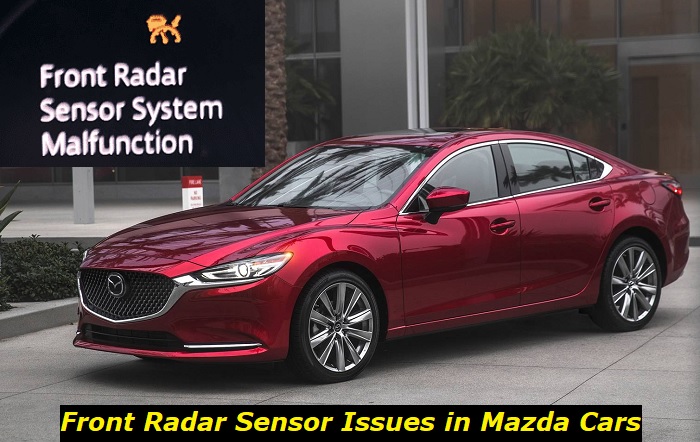Some Mazda vehicles are equipped with advanced driver assistance systems (ADAS), which are designed to enhance the safety of the vehicle and its occupants by detecting and reacting to obstacles and hazards around the car. An important component of this system is the front radar sensor system, which uses radio waves to detect incoming objects and vehicles from the front of the car. However, Mazda front radar sensors can malfunction, resulting in disabled ADAS functions.
Front radar sensor system malfunction message highlights
- Common reasons:radar area dirty, radar disconnected, radar broken, software issue
- How to fix:clean the radar area, disconnect the battery for some time
- Possible consequences:several smart functions won't be working
- Priority level:Low
- Can you drive?Yes
- DIY repair:Possible but complicated
- Repair price range:$0-$550

Causes of Front Radar Sensor System Malfunction
As the owner of a Mazda vehicle with a front radar, it is important to know the potential causes of a malfunction. This will help you diagnose the source of the problem if you ever run into it, so you can get your ADAS fully operational again as soon as possible.
Here are some of the things that can go wrong with your front radar to cause this malfunction.
- Low Battery
The proper functioning of the system may be compromised if the battery voltage is insufficient. The radar requires a voltage of 12 volts to perform optimally. If the voltage falls below this level, the radar may struggle to operate effectively. Additionally, the computer may display various errors due to components not functioning properly. It is important to ensure that the battery voltage is sufficient in order to avoid these issues and ensure the smooth operation of the system.
- Dirt or Obstruction on the Radar
The front radar is very sensitive to dirt and obstructions. Even a small layer of rainwater can render the sensor inoperable. This is because the front radar operates by emitting radio waves and measuring how long they travel before bouncing back to the sensor.
This allows the system to measure the distance between the car and incoming obstacles. When the sensor is covered with dirt, it has a hard time emitting and receiving these radio waves, leaving the radar blind.
The radar can be blocked by more than dirt. It is located behind the grille or front emblem and can be blocked by physical obstructions like a bent or misaligned grille, or objects like sticks or stones physically lodged in the grille.
- Electrical Issues
Bad electrical connections and damaged wires can cause a malfunction in the front radar sensor. The power connectors may have come loose from impacts or collisions to the front of the car. This will cause no signal to be sent between the sensor and the computer.
- Faulty Front Radar Sensor
If the radar is damaged or faulty, then the computer will continue to display this error as it fails to access the sensor. The radar sensor is located right behind the grille, where it can easily be damaged by collisions and impacts.
- Cold Weather
Some Mazda owners, particularly Mazda CX-9 owners, have complained that their front sensor fails when the temperature drops. This could be due to a variety of factors, such as the temperature sensitivity of the sensor itself, the materials used in its construction, or other design issues.
How to Fix Front Radar Sensor System Malfunction
If you are experiencing a front radar sensor system malfunction in your vehicle, it is important to take steps to diagnose and fix the problem as soon as possible. Before you begin, it is crucial to identify the cause of the malfunction. Once you have a better understanding of what is causing the malfunction, you can then consider attempting to resolve the issue using one of the following methods:
- Charge or Replace the Battery
To test whether the malfunction is caused by a weak or bad battery, you can test the voltage level with a voltmeter. The battery voltage should be 12 volts. If it is significantly lower than this, then the battery needs to be recharged. If the battery is older than three years, then it should be replaced.
- Clean the Front Radar Sensor
You can easily examine the front radar to find out if it is dirty and needs cleaning. It is located behind the front grille. Check the grille for blockages like leaves, sticks, and insects. Make sure to clean these obstructions out of the grille if you find any.
Check the radar sensor itself and examine its surface for dirt. You may find snow, water, mud, or dead insects on the radar. Wipe it clean of all dirt.
- Examine the Electrical Connections
If you suspect the radar malfunction is a result of electrical issues, then you will need to examine the wiring and the electrical connections.
Inspect the wiring and look for visible damage to the wiring or connectors leading to the radar sensor. If you find any wires that are broken or fraying, they will need to be replaced.
Check for loose connections, and make sure that all wires connecting to the radar sensor are properly and firmly inserted into their connectors. Tighten any loose connections you find. If there are any damaged connectors, they will need to be replaced.
- Replace the Faulty Radar Sensor
To troubleshoot a faulty radar sensor, start by inspecting it for any visible damage. The sensor is located behind the grille, and you can use a repair guide to find its exact location. If you find that the sensor is damaged, it will need to be replaced. You can have the sensor replaced at an authorized Mazda dealership.
- Warm the Sensor
If you find your sensor is failing often in cold weather, you can try to warm it up before starting your car. Using a hair dryer, gently heat the sensor. Make sure not to keep the dryer pointed at the sensor for too long, in order to avoid damaging the sensor's internal components with heat. Stop applying heat once the sensor is warm to the touch. Do not let the sensor get too hot.
Cold weather causes the contraction of certain materials, which can cause metal connectors to come loose. Cold weather can also cause plastic to become brittle and break easily. Make sure to examine the wiring for loose connectors and broken wires if the radar starts to malfunction when the weather is cold.
It is important that you carefully follow these steps and take necessary precautions to avoid damage to the system. If you are unsure about how to fix the problem, it is recommended to seek the assistance of a trained professional.
Environmental Causes
You might have tried every fix possible, and this malfunction refuses to go away. Maybe it pops up every time you reach a certain part of a certain road, or you might only notice it when going through tunnels. If this is the case, you might be dealing with environmental causes.
Because the system uses reflected radio waves to locate obstacles, it might not work in certain situations and conditions that create a non-reflective environment around the car. Here are some environmental conditions and situations where the system might not work as it should.
- Roads with no reflective objects in range
- In tunnels with a rounded shape
- Roads with high barriers on one side
- The car is facing direct sunlight
- Fog or dust in the air surrounding the car
These problems are a result of the sensor having trouble deciphering the signals in these conditions. Some of these can be solved by upgrading your sensor unit to the latest version. However, there might still be some conditions where these environmental conditions will temporarily disable the front radar sensor.
Conclusion
Mazda vehicle owners need to be aware of the causes of front radar sensor malfunctions and how to identify them. These malfunctions can affect the performance of advanced driver assistance systems and reduce the safety and convenience of the vehicle.
The main cause of front radar sensor malfunctions is obstructions and dirt on the radar sensor. The problem can also be caused by a faulty unit or problems with the radar's electrical connections.
It is important to know when the malfunction is caused by a hardware problem, and when it is being caused by environmental factors, like sunlight, dust, or the shape of the road, which are out of the driver's control.
About the authors
The CarAraC research team is composed of seasoned auto mechanics and automotive industry professionals, including individuals with advanced degrees and certifications in their field. Our team members boast prestigious credentials, reflecting their extensive knowledge and skills. These qualifications include: IMI: Institute of the Motor Industry, ASE-Certified Master Automobile Technicians; Coventry University, Graduate of MA in Automotive Journalism; Politecnico di Torino, Italy, MS Automotive Engineering; Ss. Cyril and Methodius University in Skopje, Mechanical University in Skopje; TOC Automotive College; DHA Suffa University, Department of Mechanical Engineering






Add comment